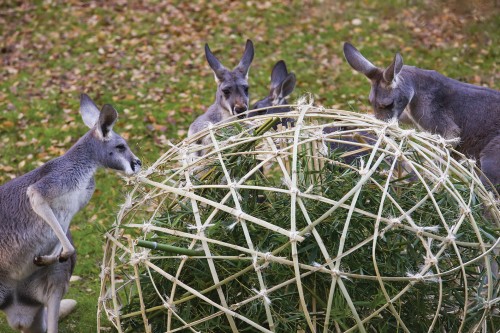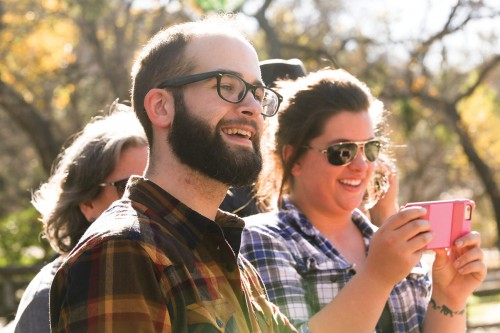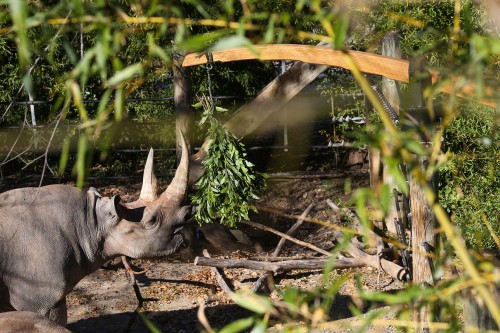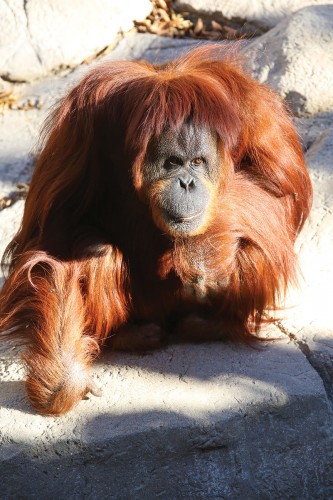
Habitat inventions at Fort Worth Zoo
Science meets art in a new interdisciplinary course designed to boost animal activity at the Fort Worth Zoo.
The Australian red kangaroo is noted for its intelligence and inquisitive nature. Whether in its native outback or at the Fort Worth Zoo, the curious marsupial is smart enough to know that it’s often too blazing hot to forage for food in the midday sun.
Its natural instinct is to stretch out and relax until dinnertime.
“For a zoo patron, that’s not very interesting,” said junior environmental science major Kat Findley of Colbert, Ga. “The kangaroo habitat is nice and large, and we wondered how the kangaroos might move around more, especially closer to the viewing area.”
But the reddish-brown mammal with long, pointed ears and a squared-off muzzle does scavenge before dusk occasionally — if it can find enough shade, Findley learned along with fellow environmental science major Patrick Ryan and ceramics major Sydney Williams.
Could they build a device that would rouse the roos’ natural instincts?

The foraging simulator is a big hit with the zoo’s red kangaroos.
That challenge was part of a new interdisciplinary course called Zoo Enrichment, developed in the fall by faculty members in two TCU colleges. Cameron Schoepp, associate professor of art, and Victoria (Tory) Bennett, assistant professor in the School of Geology, Energy & the Environment, designed and taught the class, dividing 15 graduate and undergraduate students into teams of three to study and observe species behavior before devising an object or structure to coax out instinctive behaviors and boost activity in the habitat.
Biology and environmental science students led the research effort, while art majors, ranging from painting to sculpture to art education, guided the concepting and design. By the midpoint of the semester, each team had to create a model of its idea and present it to zoo administration and animal caregivers for approval.
Placing diversions in animal exhibits is a familiar enrichment tactic at the Fort Worth Zoo, said Jenny Elston, curator of conservation and behavior. Past efforts have included balls and toys or hiding food and treats in ice.
The TCU student teams were asked to build on that.
At a zoo site visit, the red kangaroo team noted bamboo decor around the marsupial exhibit. Yet the Australian mammal doesn’t eat bamboo, instead preferring underbrush and other bushes.
But it gave the group an idea. “Bamboo is flexible and strong, so we thought it might be a good material to work with. It also has a natural color that fit the habitat,” said Williams.
It’s also lightweight. The team thought a foraging structure should be portable, and they settled on a curved shape.
The class is a great segue into the real world, solving issues and improving habitats.
Tory Bennett
Eventually, their concept became a sphere with string tying together bamboo rods. Inside the shell, keepers could hide leafy plants, brush and other goodies for the kangaroos to rip away and munch on with their sharp teeth.
While marsupials’ hindquarters are stronger, their front paws are dexterous enough to reach and pull limbs, Ryan said.
“We didn’t see that behavior at the zoo, but we learned that during our research,” he said. “We were curious to see if we could draw out that natural behavior.”
In December at the project reveal, the team’s hunch proved correct, as the kangaroos picked at an afternoon snack with both front paws.
“We worried that they might try to eat the string tied to the bamboo, but they went straight for the brush,” Findley said.
In a way, the projects are similar to public art, said Schoepp, who came up with the idea for the course when a friend’s daughter asked if he made toys for elephants in his art studio.
“In art, we always talk about audience,” he said. “In this case, it’s partly the animals, partly the zookeepers, partly the public. All three had to be addressed in this challenge.”

Students Paul Gunter and Mallory Melton designed the new rhino toy.
After that, student teams had several logistical details to sort. “Then there’s the problem-solving aspect,” Schoepp said. “What materials can hold up to an orangutan or bear or rhino? What shape and size is safe for a river otter? These are difficult questions.”
Observing the scrapped tree trunks in the rhino yard, the African black rhino team initially sought to construct a rubbing post to help the 2,000-pounders brush their massive sides and backs.
The challenge was to build a device that wouldn’t be destroyed.
Paul Gunter

An African black rhino forages at its new browse feeder.
But they also soon noticed limited natural feeding options with the few trees around already picked over, so they switched to a plan to stimulate food browsing.
“They’re natural browsers, so we wanted to simulate the activity of ripping tree branches and eating fruit,” said Beau Hartweg, a science education graduate student.
The team devised a feeder arm using Marine-grade plywood and a curved metal jig with a steel cap and shock absorber, which is weatherproof and should handle the wear and tear of the African beast, said Paul Gunter, an art education major.
“The challenge was to build a device that wouldn’t be destroyed,” Gunter said. “This should last them a long time.”
The shock absorber is designed to mimic the natural give rhinos would encounter with a tree branch, said environmental science major Mallory Melton, who traveled to Africa in the summer and worked with endangered white rhinos.
Rhinos also used their horns to dislodge fruit, which the browser feeder supports.
Best of all, zookeepers can load the device with branches on a daily schedule, leaving the tree population unaffected.
“Our goal was to tie the information the zoo is already providing to activity we could stimulate,” said Hartweg. “It’s very satisfying to see the rhinos take to the feeder right away and display the behaviors described on the exhibit markers.”
For Bennett’s science students dreaming of a career in wildlife ecology, Zoo Enrichment was good preparation, she said.
“The class is a great segue into the real world, solving issues and improving habitats,” Bennett said.
Of all the exhibits at the Fort Worth Zoo, the habitat for the Sumatran orangutan is most unlike its natural world — a rainforest.
That’s what Martin McQueen, Barrett Ray and Kayce Denkhaus initially intended, imagining a pump system that would draw water from the primates’ water source and simulate frequent precipitation.
But the scope soon grew too large and complex, and zookeepers pushed for an alternate concept. From its research, the team had imagined a secondary element to the rainforest — a tree stump that collects water, becoming a drinking source.

A wise Sumatran orangutan contemplates his new drinking hole.
In the wild, oragutans spend 95 percent of their time in the trees. While avoiding predators, they find tree holes and dip their arms inside to get their long body hair wet. Then they slurp off the water.
“We saw a video of this activity, and we wondered if they could perform that behavior in the zoo,” said Barrett Ray, a speech pathology major.
To build it, the team used part of an actual tree trunk to shape a clay and metal shell, which they later covered with epoxy and plaster and eventually painted.
“It was a long process to make, and it was the first time we’d used the materials,” said Kayce Denkhaus, an art studies major.
Materials such as bolts, scrap metal and epoxy became a commodity, and teams wouldn’t have finished the projects without donations and generous pricing from vendors, Schoepp said.
The American black bear team used donated fire hose from Fort Worth Fire Department Unit No. 21 to construct a pyramid-shaped foraging structure. The North American river otter group incorporated Plexiglass and Styrofoam, plus leftover piping from an old HVAC system.
“Being resourceful was part of the challenge and made us appreciate how our enrichment object came together,” said Andria Beal, a biology graduate student.
On the day after the December project reveal, Fort Worth Zoo officials posted a video on social media of scenes of the animals interacting with the structures.
“The TCU students did a marvelous job. Their creativity and ingenuity were very impressive,” Elston said.
Mixing art and science students was mutually beneficial, said Anastasia King, an art sculpture major, who worked on the bear team.
“The art majors learned research and data collection techniques. The environmental science majors worked on design for the first time — concepting, material use, construction. Both brought critical thinking and problem-solving skills to the table,” she said.
Just before the Christmas break, McQueen received an email from wildlife ecology professor Bennett. It contained a link to a video of the team’s orangutan pulling a hairy limb out of the tree hole — something the primate hadn’t done at the end-of-semester presentation.
“It made my day. It made my semester,” McQueen said. “This thing we made — our Plan B — was being used. It worked! We made their home better, hopefully for a long time.”

Students used fire hose donated by the Fort Worth Fire Department for this pyramid feeder for the zoo’s black bear.

Your comments are welcome
Comments
Related reading:
Campus News: Alma Matters
Spring Breakout
Forget South Padre. Spring Break has become an intensified mini-mester of out-of-classroom learning, often overseas.
Letters
From the chancellor: Fostering innovation
In a March 2015 article about higher education innovation, Fast Company magazine featured our Rees-Jones Hall, describing it as “an incubator facility designed to maximize social and intellectual connectivity.”